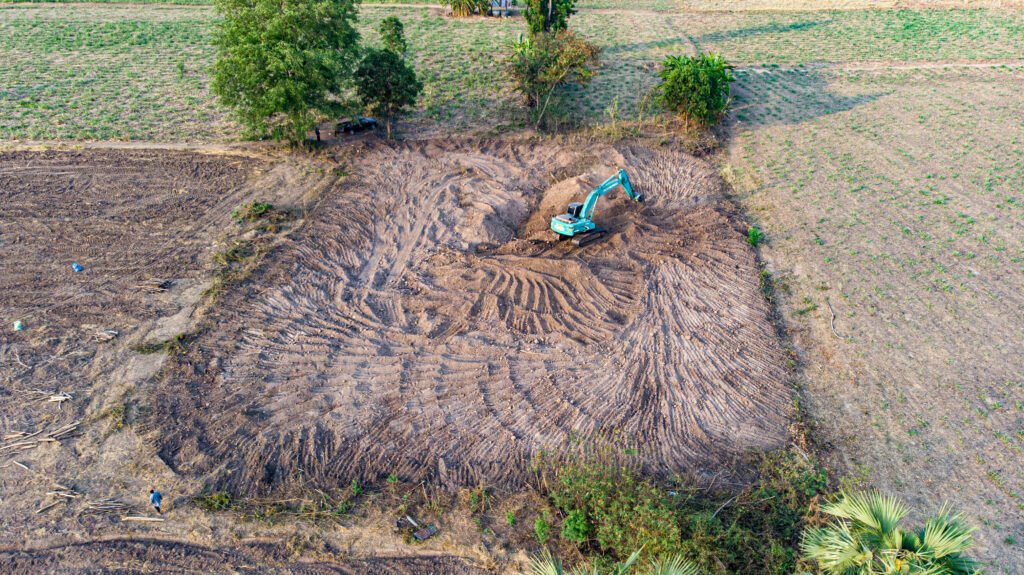While not something we actively think about, land grading is a vital part of the construction and landscaping process. It levels uneven landscapes, shifts around soil, and creates flats and slopes that facilitate smooth and safe construction. From the initial excavation to the last bit of soil relocation and everything else in between, this blog is here to help you understand the importance of land grading for any property owner.
A Brief Look At The Process Of Land Grading
Land grading is the process of reshaping the topography of your land to suit your requirements. This involves excavating excess soil, rocks, and other materials to create a smooth surface to begin the grading process. Next, the land is shaped, creating inclines, flat surfaces, or ridges till the property is ready for whatever project you might have.
Perks & Pros Of Land Grading
Simple enough? Great! But why go through all the trouble to level your property? Aside from the few obvious factors, such as creating smooth surfaces for construction work, there are quite a few more benefits of investing in land grading services.
Here is a look at a handful of reasons why you should grade your land.
Structural stability
One of the most common reasons why property owners invest in this service is that it creates an even, stable area for constructing buildings and installing driveways. Otherwise, you run the risk of uneven settling, which could lead to foundation issues and uneven paving in the future.
Enhanced drainage and water management
Yet another vital reason for investing in land grading is the fact that properly designed slopes and inclines direct rainwater away from your foundations. This not only prevents water damage but also protects your plants and trees from flooding. In addition to this, mosquitoes and other pests are discouraged from sticking around as there is no ponded water for them.
Soil Erosion Prevention
Another environmental benefit is, land grading distributes all the soil evenly throughout the property. Meaning, in case of heavy rains, you won’t have to worry about soil run-offs or potential damming of natural water bodies nearby.
An Even Footing
For large properties residing in hilly areas, efficient land grading is especially important. Residents and visitors face the risk of tripping or slipping down slopes or uneven dips in the ground, so turning steep hills into gentle slopes is a great way to prevent injuries.
Improved Aesthetics
An uneven piece of property gives off a messy and neglected vibe. By creating a level surface, landowners may find that their property looks more attractive to visitors as well as creates positive vibes among residents.
Preparing for landscaping
Next, use this newly created beautiful space to set the stage for your landscaping project. Plan walkways, plant gardens, and install driveways that not only provide access but also add to the charm of your property.
Laying The Groundwork For Construction
As previously mentioned, land grading is important before construction can begin on rough and uneven terrains. By creating a level surface, technicians create an even and stable space for erecting homes, buildings as well and complexes so that the foundations stay strong and the structures stay standing for a long time.
Optimizing Land Utilization
Since the purpose of land grading is to get rid of steep inclines and awkward contours, it’s an excellent way to make use of your entire property. That raised area in the middle of your yard can now be used as a garden to plant your favorite flowers, and the bumpy corner can be turned into a play area for the kids once cleared.
Increased property value
Compare an uneven property with ridges and bumps to one that’s prepped and primed for further project potential. When you go to put it up on the market, buyers are more likely to lean toward a graded piece of property over a rough terrain, meaning you’d receive a higher price for its sale. This makes land grading a smart investment tactic.
Conclusion
Land grading is the process of levelling slopes and smoothing bumps on various residential and commercial properties to create an even surface. It’s a prerequisite of construction and landscaping and adds to the value, charm, and safety of the land. We hope this blog helped you get a better understanding of land grading and its uses. For any more questions, feel free to drop us a line.
FAQs
How long does professional land grading take?
Depending on the complexity of the project, professional land grading is completed within a day or two.
What kind of soil should I use for land grading?
For the base layer, use clay, and for the top layer, opt for topsoil for healthy plant growth.
Can I grade my land myself?
If it’s a small area with a relatively simple landscape, homeowners can usually grade the land themselves.

